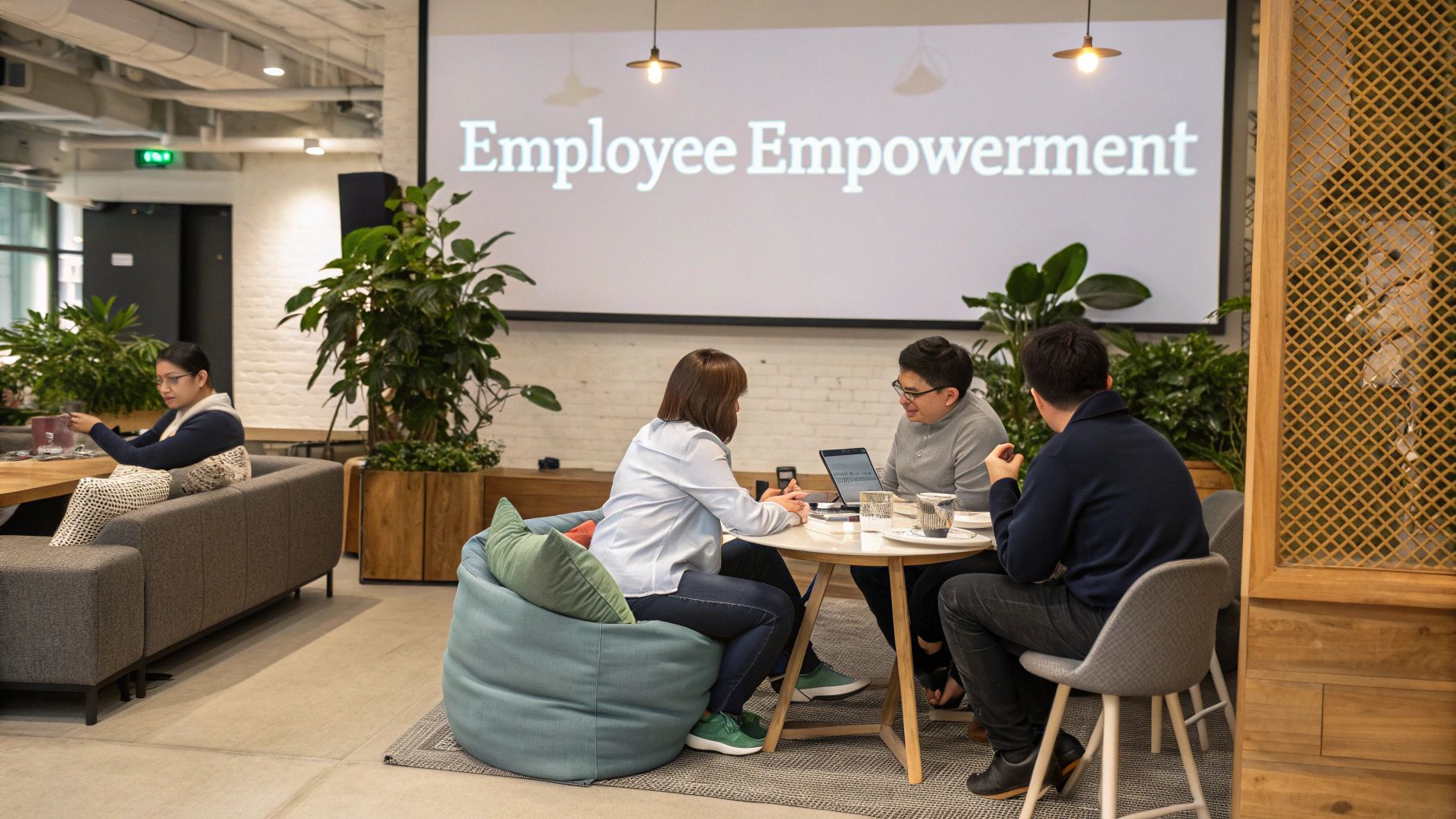Imagine walking into a workplace where every employee feels confident, valued, and capable of making meaningful decisions. This isn't just a dream scenario – it's the reality for organizations that have mastered what is an essential factor for employee empowerment. But before revealing this crucial element, let's explore why empowerment has become the cornerstone of successful modern businesses.
Understanding Employee Empowerment: Definition and Core Concepts
What Defines True Employee Empowerment
Employee empowerment goes far beyond simply delegating tasks or giving workers more responsibilities. At its core, it represents a fundamental shift in organizational culture where employees gain the authority, resources, and confidence to make decisions and take initiative in their roles. Think of it as giving workers both the keys to drive and the map to navigate their professional journey. The concept encompasses three main elements: authority to make decisions, access to necessary resources, and accountability for outcomes. When organizations properly implement what is an essential factor for employee empowerment, they create an environment where workers feel trusted and capable of contributing meaningfully to the company's success.
The Role of Empowerment in Modern Workplaces
In today's rapidly evolving business landscape, traditional hierarchical structures are giving way to more flexible and responsive organizations. Modern workplaces recognize that empowered employees are more engaged, innovative, and committed to their organization's success. They understand that empowerment isn't just a buzzword – it's a strategic advantage that drives business performance and employee satisfaction.
Trust: The Most Essential Factor for Employee Empowerment
Building Trust Between Leaders and Employees
Trust stands as what is an essential factor for employee empowerment, serving as the foundation upon which all other elements build. Without trust, even the most well-intentioned empowerment initiatives will fail. Leaders must demonstrate confidence in their team's abilities and judgment, while employees need to feel secure in taking calculated risks without fear of punishment for honest mistakes. At companies like Neroia, where employee empowerment is central to the organizational culture, trust-building starts from day one through transparent communication, consistent support, and clear expectations.
Creating a Culture of Psychological Safety
Psychological safety creates an environment where employees feel comfortable expressing ideas, raising concerns, and making decisions without fear of negative consequences. This safety net encourages innovation and problem-solving while fostering genuine empowerment.

Key Components of Successful Employee Empowerment
Autonomy and Decision-Making Authority
True empowerment requires giving employees real authority to make decisions within their scope of responsibility. This means allowing them to: Choose how to accomplish their tasks Make decisions about their work processes Take ownership of projects and outcomes What is an essential factor for employee empowerment becomes evident when organizations grant meaningful autonomy while providing appropriate guidance and support.
Access to Resources and Information
Empowered employees need access to: Relevant data and information Necessary tools and technology Training and development resources Support from leadership and colleagues
Professional Development Opportunities
Organizations must invest in their employees' growth through: Skill-building programs Mentorship opportunities Career advancement pathways Regular feedback and coaching
The Business Impact of Employee Empowerment
Increased Productivity and Innovation
When employees feel empowered, they take greater ownership of their work and feel more motivated to contribute innovative solutions. This leads to:
Higher efficiency in daily operations
More creative problem-solving
Increased workplace innovation
Better resource utilization

Enhanced Employee Retention
Empowered employees are more likely to stay with their organizations because they: Feel valued and respected See opportunities for growth Experience job satisfaction Have a sense of purpose
Improved Customer Satisfaction
Empowered employees directly impact customer satisfaction by: Making quick decisions to resolve issues Providing personalized service Taking initiative to exceed expectations Building stronger customer relationships
The impact of employee empowerment extends beyond internal operations to create positive ripple effects throughout the entire organization. When employees feel trusted and supported, they naturally become more invested in the company's success and their own professional growth.
Implementing an Employee Empowerment Strategy
Setting Clear Expectations and Boundaries
For employee empowerment to succeed, organizations must establish clear guidelines that define the scope of employee authority. This balance between freedom and structure is what is an essential factor for employee empowerment. Team members need to understand exactly where their decision-making power begins and ends.
Clear expectations help employees feel confident in taking initiative without fear of overstepping. For example, a customer service representative might have the authority to offer refunds up to a certain amount without supervisor approval. This empowers them to resolve issues quickly while maintaining appropriate controls.
Boundaries should be documented and communicated through formal policies, but also reinforced through regular discussions and practical examples. When employees understand their parameters, they're more likely to act decisively within them.
Developing Effective Feedback Systems
Two-way communication channels are crucial for sustaining empowerment initiatives. Employees need regular opportunities to share their experiences, challenges, and suggestions. Similarly, managers must provide timely, constructive feedback to guide empowered decision-making.
Effective feedback systems might include: Regular one-on-one meetings focused on development Anonymous suggestion platforms Team retrospectives to discuss what's working and what isn't Peer feedback mechanisms
The key is creating an environment where feedback flows naturally and continuously, rather than being limited to annual reviews or formal evaluations.
Creating Empowerment Metrics
Organizations need concrete ways to measure the success of their empowerment initiatives. These metrics help track progress and identify areas needing adjustment. Effective measurement considers both quantitative and qualitative indicators.
Key metrics might track employee satisfaction, decision-making speed, customer satisfaction improvements, and innovation rates. Regular assessment of these metrics helps organizations understand what is an essential factor for employee empowerment in their specific context.
Common Challenges in Employee Empowerment
Overcoming Resistance to Change
Change often faces resistance, especially when it involves shifting traditional power dynamics. Some managers may feel threatened by giving up control, while employees might be hesitant to take on additional responsibility. Understanding and addressing these concerns head-on is what is an essential factor for employee empowerment success.
Organizations can overcome resistance by: Demonstrating clear benefits through pilot programs Providing support and training for both managers and employees Celebrating early wins and sharing success stories Addressing concerns openly and honestly
Balancing Freedom with Accountability
While empowerment grants employees more autonomy, it must be paired with appropriate accountability measures. This balance ensures that increased freedom leads to positive outcomes rather than chaos. Organizations need to develop frameworks that support responsible decision-making while maintaining necessary oversight.
For instance, teams might have the freedom to choose how they complete projects but must still meet agreed-upon deadlines and quality standards. This approach maintains accountability while respecting team autonomy in execution.
Managing Risk and Failure
Empowered employees will occasionally make mistakes, and organizations must be prepared to handle these situations constructively. Creating an environment where calculated risks are encouraged and failures are viewed as learning opportunities is what is an essential factor for employee empowerment sustainability.
Organizations should establish clear protocols for risk assessment and provide guidance on when to escalate decisions. This helps employees feel supported while maintaining appropriate risk management.
Best Practices for Sustaining Employee Empowerment
Regular Recognition and Rewards
Acknowledging and celebrating empowered behavior reinforces its importance in organizational culture. Recognition can take many forms, from public acknowledgment in team meetings to formal awards programs. The key is consistency and authenticity in recognizing employees who embrace their empowered roles.
Continuous Learning Programs
Empowerment requires ongoing skill development. Organizations should provide regular training opportunities that help employees grow into their expanded responsibilities. This might include leadership development, decision-making workshops, or technical training relevant to their roles.
Measuring and Adapting Empowerment Initiatives
Success in employee empowerment requires regular evaluation and adjustment of initiatives based on feedback and results. Organizations must stay flexible and responsive to changing needs while maintaining core empowerment principles.
For companies looking to implement or enhance their employee empowerment strategies, platforms like Neroia can play a crucial role by fostering the social connections and engagement that naturally support empowerment initiatives through their AI-driven social benefits platform.


